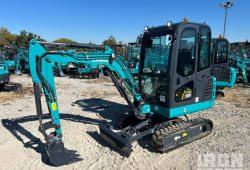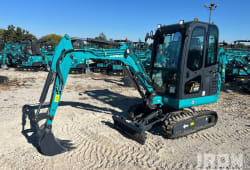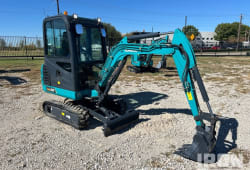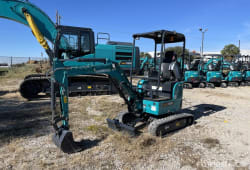How to Choose the Best Mini Excavator For Your Next Project
12 Lectura mínima
)
mayo 11, 2023
The excavator is a heavy-running system available in an extensive range of sizes.
Standard excavator sizes include:
:format(webp))
Mini excavator or compact excavator (variety 5,000 to fourteen 000 kilos)
A smaller excavator is used for jobs in tight areas requiring a lighter gadget. It makes them the perfect transport among task sites and offers excellent gasoline efficiency. Compact excavators are typically used for driveway or landscaping projects.
Medium-rated excavator or mid-sized excavator (range 14,000 to ninety 000 kilos)
Standard excavators are used while electricity is used. These excavators can break into more difficult surfaces, such as thick concrete foundations.
Large frame excavator (range 90,000+ kilos)
Large excavators are supposed to be used for main commercial projects, including mining. These are intensely practical machines, but they can be challenging to transport and shop if you intend to move the gadget frequently. These are the least economical excavator options because they relate to gas consumption.
:format(webp))
Important Mini Excavator Specs
In identifying between compact production devices and standard excavators, you'll want to recollect the subsequent vital factors:
Frame size
Operating weight
Maximum digging intensity
Maximum sell-off top
Bucket breakout force
Tail swing
Let's discover what these metrics suggest, after which we can run through the pinnacle mini excavator brands and exemplary mini excavator models.
Size Dimensions
First, evaluate the mini excavator's size relative to that of the construction website you may be working on. Will it match your attitude while getting used to the course or the attitude you want to use to finish the challenge?
Operating Weight
Operating weight method: the overall weight of the mini excavator when gas, attachments, and the human heavy system operator's weight are accounted for. Ask: Is this gadget too heavy? Will it damage utilities or the terrain beneath?
:format(webp))
Maximum Dig Depth
Maximum dig depth means precisely what it seems like. The max digging depth is the furthest into the earth that the mini excavator can reach. How deep does your mini excavator want to dig without tipping?
As part of this consideration, you may also need to factor in the maximum vertical dig intensity. This method determines how far deep the machine can dig a vertical wall without endangering the operator.
Maximum Dump Height
The max dump top measures how high the mini excavator's arm can expand and empty a full load without tipping. It means comparing the max sell-off peak to the peak of the truck or floor substances that will be dumped into or onto.
:format(webp))
Bucket Breakout Force
Bucket digging pressure or breakout force is the quantity of electricity a mini excavator can exert towards the fabric it's miles digging into. Breaking into dense, solid substances consisting of concrete will require an extra breakout force than operating with unfastened soil or gravel.
Tail Swing Configuration
The tail swing design can be a 0-tail or traditional tail swing. The mini excavator market is usually produced from 0 tail swing excavators. That way, they can rotate over the undercarriage width compared to their conventional tail counterparts, which consist of a counterweight that extends past the system's undercarriage width.
The advantage of zero tail swing configuration determined in compact models is extra maneuverability in small areas. A reduced tail swing design may be found on most compact models.
:format(webp))
Now that we understand the essential elements to consider when selecting compact models and conventional excavators let's take a short look at the issues that affect the selection of all production equipment.
Pro Tip: How to Become A Heavy Equipment Operator
:format(webp))
Factors to Consider in Choosing Any Construction Equipment
The best mini excavator features overlap with the most vital considerations for any heavy-responsibility production gadget.
The pleasant construction device regularly comes right down to asking yourself:
Did an excellent manufacturer make it?
Is the charge appropriate for the advantages to be received using its typical mission?
How much does gas consumption costs frequently upload to the rate?
Is this production equipment compatible with the proper attachments?
Does the system's hydraulic energy provide enough capability to carry heavy loads?
Does this device have enough engine pace?
Is the cab a type that lets the operator maneuver the device as wished?
Do you select gas-powered or electric-powered mini excavators?
:format(webp))
Reputable Mini Excavator Brands
The pinnacle mini excavator brands -- you might not be taken aback to discover -- are built on identical excessive-overall performance reputations for making construction devices of all types.
The first mini excavator was the Takeuchi TB1000, which was made in Sakaki, Japan, in 1971. It was designed for the digging depth required for home foundations. Compact excavators have developed substantially since 1971.
7 of the quality mini excavator manufacturers in 2023 consist of:
John Deere
Kubota
Yanmar
Sany
Bobcat
Komatsu
Caterpillar
Wacker Neuson
John Deere mini excavators
Compact John Deere excavators weigh between three,800, and 13,500 pounds; most dig depths are seven to twelve toes.
One of John Deere's most popular compact excavators is the 2018 John Deere 25G Excavator.
:format(webp))
Kubota Mini Excavators
Kubota's smallest mini excavator is the Kubota K008-five, which weighs 2,315 kilos and has a five' 8" max digging depth. The Kubota U Series and Kubota K Series compact excavators are among the nicest mini excavators available on the market nowadays. The difference among these collections typically comes right down to the compact machines' 0 tail swing configuration or reduced tail swing design.
One model that has Mountearnedta's recognition as a pinnacle-ranked mini excavator logo is the 2017 Kubota KX080, one of the excavator brand's largest mini excavators.
Yanmar Mini Excavators
The smallest Yanmar mini excavator, the ViO10-2A model, weighs an insignificant 2,700 pounds and has a maximum dig depth of slightly over 6 feet.
:format(webp))
Sany Mini Excavators
A Sany mini excavator, even a used one, will typically have a better fee factor due to its exquisite production interior and exterior.
Sany's smallest mini excavator is the Sany SY19E Electric Mini Excavator, which has an operating weight of three 900 kilos and a maximum dig intensity of approximately 7 half feet.
One of the best mini excavator models that Sany has to offer is the 2020 Sany S795 Mini Excavator.
:format(webp))
Bobcat Mini Excavators
The maximum "mini" of Bobcat compact excavators is the R-Series Bobcat E10 Mini Excavator. This mini excavator weighs 2,593 kilos with the most dig depth of 6 feet.
The 2017 Bobcat E50 Excavator is one of the most compact Bobcat models sold, supplied as a used mini excavator at Boom and Bucket.
:format(webp))
Komatsu Mini Excavators
Komatsu's smallest excavators have a working weight of 6,812 kilos. It is one of the most crucial mini excavator manufacturers.
The famous 2018 Komatsu PC8US-10 small excavator weighs approximately 18,000 pounds. Komatsu's compact excavator's stable size with power for a flexible gadget.
:format(webp))
Caterpillar Mini Excavators
These mini hydraulic excavators weigh between 2,200 kilos and 20,000 pounds.
One of Caterpillar's most powerful mini excavators is the 2019 Caterpillar 308CR mini excavator model, which weighs 20,000 pounds, the highest of this weight variety.
:format(webp))
Wacker Neuson Mini Excavators
The smallest Wacker Neuson zero-tail excavator today has a running weight of approximately 5 412 kilos and a maximum digging depth of nine toes. It is the 2023 Wacker Neuson EZ26 Zero-Tail Excavator.
Wacker Neuson produces an extensive range of compact excavators with fluctuating rate factors. A particularly popular Wacker Neuson model is the Wacker Neuson EZ38 mini excavator.
:format(webp))
The Cost-Benefit Analysis When Buying Mini Excavators
The key idea here is to measure the fee to function, hold, shop, and ship your device towards the profit to be received with its use.
Significant concerns here include such prices as:
Fuel and engine oil fees
Electric charging in case you do decide against a diesel engine
Cost to transport the excavator from Point A to Point B, and the way often it will be transported
How much garage space does the device require, and what are the fees
Level of wear and tear and tear it'll take and the resulting upkeep charges
The kind and number of attachments the activity calls for
These costs can vary widely between small- and medium-scale initiatives, including repairing sewer strains, compared to big-frame industrial excavators, which can be used as agricultural equipment or take over huge mining initiatives.
Mini Excavator Attachments
There are loads of alternatives to select from regarding excavator attachments. Many hydraulically driven attachments level up a smaller excavator with extra hydraulic strength.
A few of the most usually used attachments for compact excavators are:
Hydraulic breakers
Heavy-obligation buckets
Grapples
Brush cutters and tree shears
Pulverizers for demolition
Hydraulic compactors
Hydraulic thumbs or weld-on thumbs
Rippers
Backfill blade
Standard hydraulic quick couplers
Long-reach palms
When shopping attachments for mini excavators, it's critical to study the manufacturer's guidance as to maximum running weight in order not to cause your system to reach its tipping point and expose yourself and your group to injury.
It is also essential to consider any additional dimensions while running in tight spaces, which is generally the kind of process that maximum mini excavators have to function in.
:format(webp))
A Mini Excavator's Hydraulic Power and Engine Speed
The engine and the hydraulic gadget that powers an excavator are the most essential functions of any sized excavator.
To simplify, the engine powers the hydraulic pump, which turns mechanical force into liquid force, permitting robust, agile motion.
The motive maxima of the abovementioned manufacturers, which are ranked as top excavator logos, are high-overall performance engines and hydraulic systems.
Auxiliary hydraulics -- many of which seem inside the section on mini excavator attachments above -- may be connected to this strength powerhouse using an auxiliary hydraulic package.
Diesel engines power most hydraulic structures. However, we are witnessing an uptick in electric mini excavator options.
Mini Excavator Cab Models
When surfing mini excavators online, a crucial feature to note is the cab's health, experience, and function.
The proper mini excavator will offer a cab with intuitive operating device placement, maintain the safety of the heavy equipment operator, and offer a snug seat. If the cab design leaves the operator pissed off and in a steady kingdom of pain, they'll take more common breaks and extend the undertaking (which often method accelerated expenses).
The three primary excavator cab kinds are:
Open-pinnacle cab
Enclosed cab
Cab-over
Open-top mini excavators are the most popular because they give the operator visibility range.
Another attention that ties into the excavator's hydraulic gadget is whether the task calls for a tilting cab.
:format(webp))
Mini Excavator Tracks
You have the choice between rubber tracks and steel tracks. The tracks are the part of the mini excavator that crawls across the floor.
Steel tracks are generally preferred for buying correct traction on free surfaces.
Rubber tracks are typically used, while a job website requires that the system leaves little to no sign of impact.
:format(webp))
Putting the Pieces Together
Let's observe a simple instance. My team is presently taking over projects 30 miles away. One call for grading a website for an upcoming production, and the opposite project requires digging for an in-floor pool.
At first glance, we can see that:
The mini excavator has to be strong enough to demolish and grade a job website.
The mini excavator should be sensitive and small enough to maneuver through an belongings owner's backyard.
The small excavator must have the most dig intensity of at least the depth of the house owner's favored pool size. The shared inground pool is eight feet deep.
The cost of transporting the mini excavator among the 2 initiatives should equal the profit of tackling them. Let's assume my crew has its transport trailer and owns an equipment lot for the garage, so we want to factor in gasoline costs.
The mini excavator desires to be characteristically safe with the attachments each job requires and feature hydraulic electricity in paintings with auxiliary hydraulics.
:format(webp))
From this analysis, I would select:
A manufacturer with a robust logo reputation in crafting and powering a compact excavator (possibly a Kubota excavator for its mid-range mini excavator sizes or Bobcat mini excavators)
A device designed for specific manipulation in small spaces
A middle-weight compact excavator with low-impact rubber tracks and 0 tail swing
Versatile compatibility with backfill blades, hydraulic thumbs, brush cutters, and essential demolition attachments
A hydraulic system is sufficient to make hydraulic attachments function at their great
A maximum dig depth and most vertical dig depth that thoroughly allows the operator to dig greater than eight feet deep
:format(webp))
The 2018 Kubota KX033-4 mini excavator might be the proper mini excavator for this online activity website mixture and comparable tasks in tight areas. This system has a mid-range working weight of about 7,000 kilos, a maximum dig intensity of approximately 10 feet, an enclosed cab with full-functioning warmth and A/C, blade, bucket, hydraulic thumb, short coupler controls, and pilot controls.
Ultimately, the exceptional mini excavator brand, make, and model will come down to your most commonplace programs—the various projects you and your group address most frequently. Choosing compact machines like mini excavators when running in tight spaces is first-rate.
You have come to the correct location if you're searching for a used mini excavator or a different heavy system for your next job. Here at Boom and Bucket, our project is to be the most dependent on digital dealers for all things heavy devices and mini excavators.
We earn your agreement via transparency, fairness, and assurances backed by international-elegance technology and tremendous customer service. Follow us at @boomandbucket or contact us at boomandbucket.com.

Caleb Woods is an experienced content specialist and an editor at Boom & Bucket, blending his journalism background with expertise in the heavy equipment industry. He delivers engaging, informative content to help professionals stay informed and make smarter decisions in the machinery market.




:format(webp))










